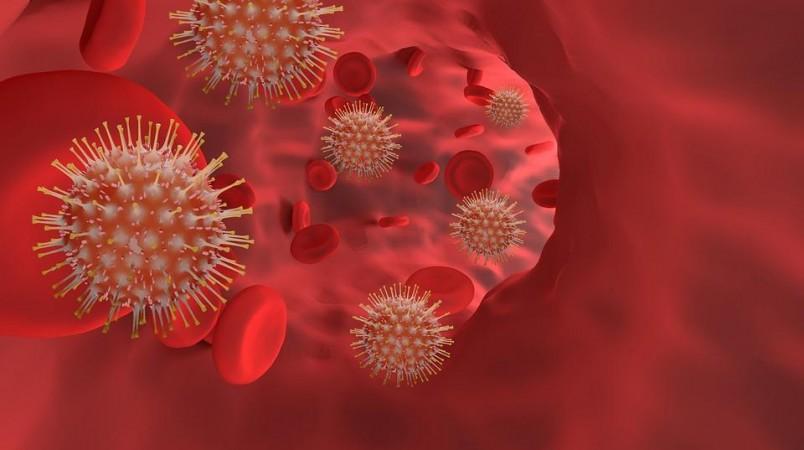Of all complications that plague COVID-19 patients, decreased levels of oxygen is among the worst. Known as hypoxia, it is characterized by low oxygenation in the body's tissues, which makes the need for its constant monitoring paramount. Now, a new study has discovered an infection mechanism of the SARS-CoV-2 coronavirus that can explain the fall in oxygen levels among sufferers of the disease.
According to scientists from the University of Alberta, the SARS-CoV-2 virus infects immature red blood cells (CD71+ erythroid precursors/progenitors, or CECs), thereby, reducing oxygen in the blood and impeding immune responses. The study also found why dexamethasone—an anti-inflammatory drug—has been effective in treating individuals struggling with the viral infection.
"Low blood-oxygen levels have been a significant problem in COVID-19 patients. Because of that, we thought one potential mechanism might be that COVID-19 impacts red blood cell production," said Dr. Shokrollah Elahi, lead author of the study, in a statement.
Increasing Immature Blood Cells

For the study, the team analyzed blood samples from 128 COVID-19 patients. The examined patients fell into three categories: critically ill and admitted to the ICU; moderate symptoms and admitted to hospital; and a mild case of infection and spent only a few hours in the hospital.
The authors learnt as the progression of the disease became severe, the amount CECs flooding into the blood circulation increased. These cells amounted to nearly 60 percent of total cells in the blood in some cases. Interestingly, in the blood of healthy individuals, immature red blood cells contribute to less than one percent of total blood cells.
"Immature red blood cells reside in the bone marrow and we do not normally see them in blood circulation. This indicates that the virus is impacting the source of these cells. As a result, and to compensate for the depletion of healthy immature red blood cells, the body is producing significantly more of them in order to provide enough oxygen for the body," explained Dr. Elahi.
Susceptibility to COVID-19

Along with their increase in numbers during infection, CECs present an important inherent problem—they cannot transport oxygen. Only mature blood cells can carry out that function of oxygen transportation. Another worrisome finding about CECs is that they are highly susceptible to COVID-19 infection. When CECs face the onslaught of the SARS-CoV-2, their destruction creates a shortage of replacements for mature red blood cells which only have a life span of around 120 days. Thus, the ability to carry oxygen through the bloodstream to all the organs is lessened.
"Immature red blood cells are the cells being infected by the virus, and when the virus kills them, it forces the body to try to meet the oxygen supply requirements by pumping more immature red blood cells out of the bone marrow. But that just creates more targets for the virus," illustrated Dr. Elahi.
How Does COVID-19 Infect CECs?
Though the mechanism behind the diminished capacity of transporting oxygen was discovered, the authors still had one question that required answering—How does the SARS-CoV-2 virus infect immature blood cells? In his previous research, Dr. Elahi had demonstrated that CECs increased the susceptibility of some cells to HIV. Therefore, the team began examining whether CECs possessed receptors that the novel coronavirus could use to infect them.

At the end of a rigorous series of studies, the team became the first in the world to demonstrate that CECs expressed the receptor known as ACE2 (Angiotensin-converting enzyme 2) and a co-receptor called TMPRSS2 (Transmembrane protease, serine 2). Both the receptors have been found to facilitate the virus in infecting cells. After conducting investigative infection testing with CECs from COVID-19 patients, the authors evidenced that the SARS-CoV-2 virus was able to infect CECs. This proved that the two receptors played the same role in the infection of CECs.
Talking about the findings, Dr. Elahi stated, "Immature red blood cells are actually potent immunosuppressive cells; they suppress antibody production and they suppress T-cell immunity against the virus, making the entire situation worse. So in this study, we have demonstrated that more immature red blood cells means a weaker immune response against the virus."
Mechanism of Dexamethasone
Armed with the discovery that CECs contain receptors that make them vulnerable to infection by the coronavirus, the scientists commenced the testing of various drugs to ascertain whether the susceptibility of CECs to SARS-CoV-2 can be reduced. "We tried the anti-inflammatory drug dexamethasone, which we knew helped to reduce mortality and the duration of the disease in COVID-19 patients, and we found a significant reduction in the infection of immature red blood cells," remarked Dr. Elahi.

As the team tried to glean the reason behind dexamethasone's action, they observed two potential mechanisms. The first was that the response of the two receptors—ACE2 and TMPRSS2—to SARS-CoV-2 in CECs was suppressed by the drug, thereby, reducing the chances of infection.
Secondly, the rate at which CECs mature is accelerated by dexamethasone, which helps the quicker shedding of the nuclei by the cells. In the absence of nuclei, the coronavirus has no site to replicate and spread. Fortunately, integrating the findings of the study into the existing therapeutic management of COVID-19 does not require any significant changes in approach.
"For the past year, dexamethasone has been widely used in COVID-19 treatment, but there wasn't a good understanding as to why or how it worked. So we are not repurposing or introducing a new medication; we are providing a mechanism that explains why patients benefit from the drug," concluded Dr. Elahi.














